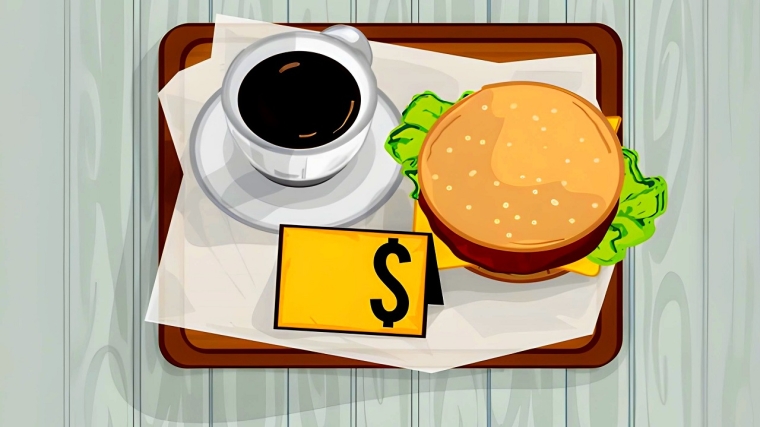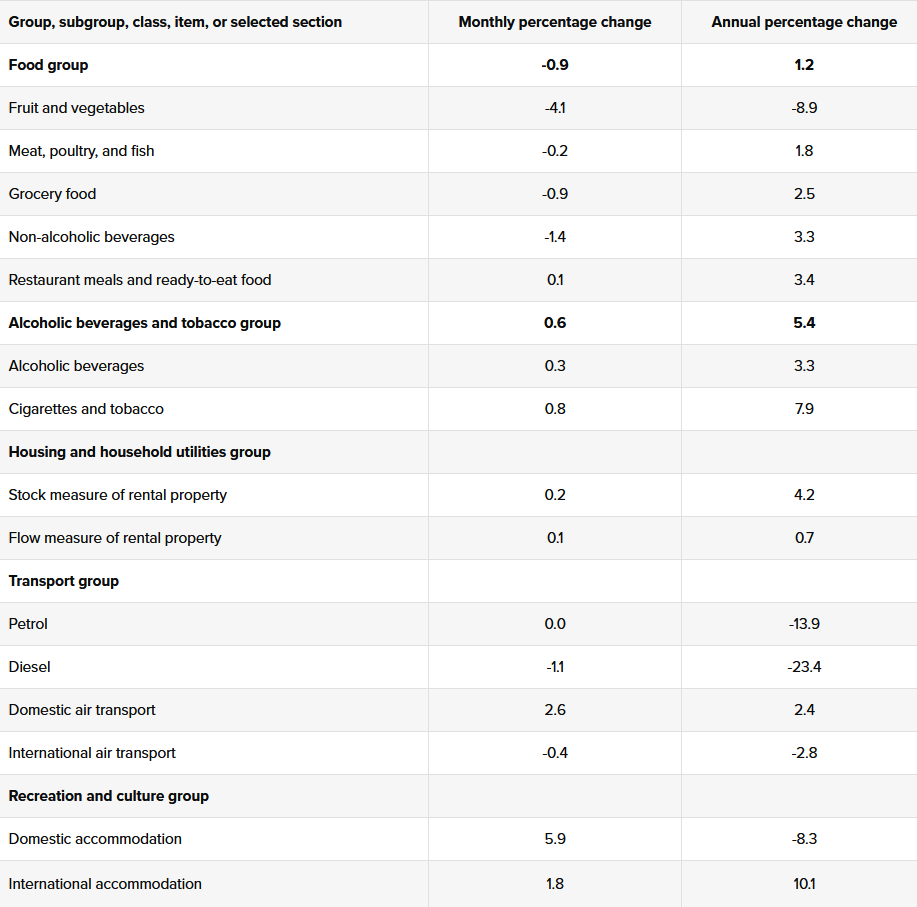
Immediate inflationary pressures look subdued and continue to point to the Reserve Bank being able to achieve its target of inflation stabilising around 2%.
That's the impression gained from the latest release of Statistics NZ's Selected Price Indexes (SPI).
The monthly SPI features goods that make up about 45% of the quarterly Consumers Price Index, the official measure of inflation. Remember that the CPI showed annual inflation of 2.2% as of the September quarter - the first time it had re-entered back into the targeted 1%-3% range since mid-2021, having gone as high as 7.3% in mid-2022.
The Reserve Bank (RBNZ) has already started reducing the Official Cash Rate (OCR), by dropping it since August from 5.5% to 4.75% as it gains confidence that inflation is under control. And a further OCR cut of at least 50 basis points is likely at the next review on November 27.
And the latest SPI seems to offer further encouragement that things are on the right track, with food prices dropping in October, while rentals - which have been rising strongly - saw their smallest annual rate of gain for 12 months. Food prices make up 18.8% of the CPI.
Westpac senior economist Satish Ranchhod said while some of the softness in prices seen this month was in volatile areas, the result more generally was "consistent with a continued cooling in underlying inflation pressures".
"We’re currently forecasting a 0.4% rise in consumer prices in the December quarter, and today’s results suggests some downside risk to that forecast.
"Importantly, our forecast is already lower than the RBNZ’s last published forecast from August for a 0.5% quarterly rise in prices. We expect the RBNZ’s upcoming policy statement on 27 November will incorporate a lower near term inflation outlook, with inflation likely to track close to 2% over the coming year, with some risk of a temporary dip below 2%. Consistent with that, we expect that the RBNZ will deliver a 50bp cut in the OCR in November," Ranchhod said.
ASB senior economist Mark Smith said the latest SPI figures suggest that 2% annual CPI inflation should likely be reached by the end of the year.
"However, downside risks to the NZ inflation outlook over 2025 look to be easing suggesting that the RBNZ may not need to push the OCR below circa 3-4% neutral levels.
"We still expect another 50bp OCR cut in November and a 3.25% OCR endpoint. However, OCR moves over 2025 will be increasingly conditional on the (still uncertain) economic outlook," Smith said.
Stats NZ said food prices fell 0.9% in October 2024 compared with September. The largest contributor to the fall was vegetables, down 7.2%. This was partly offset by a rise in fruit prices, up 0.6%.
"Over the last two years, vegetable prices have fallen 14.2%, while fruit prices have risen by 8.0%," Stats NZ's prices and deflators spokesperson Nicola Growden said.
“In October, veggies were cheaper due to falling prices for tomatoes, cucumber, and capsicum, while apples, oranges, and bananas pushed up fruit prices.”
Overall, fruit and vegetable prices fell 4.1% in October 2024. Other items that have contributed to the monthly fall include instant coffee, yoghurt, and potato crisps. These falls were partly offset by rising prices for standard 2L milk and fruit juice.
In terms of the annual picture, food prices rose 1.2% in the year to October, which was the same rate as seen for September.
Higher prices for restaurant meals and ready-to-eat food as well as grocery food drove the annual increase in food prices, up 3.4% and 2.5%, respectively.
The price increase in restaurant meals and ready-to-eat food was due to rising prices for lunch/brunch, takeaway coffees, and takeaway meals. Grocery food prices also rose, driven by higher prices for olive oil, butter, and standard 2L milk.
"A 500g block of butter now costs over one-third more than it did last year, with an average price of $6.67," Growden said.
"The price for a standard 2L bottle of milk increased around 9 percent over the same period, averaging $4.21 a bottle."

On the question of rents, these have been rising strongly in the past couple of years and have been quite a significant contributor to overall inflation. But the rates of increase are now easing. Rentals make up about 9.5% of the CPI.
In October the 'stock' measure of existing rentals rose 0.2%, which is down from 0.3% in the previous month. The annual rate of increase declined to 4.2%, which is the lowest rate of annual increase since October last year. That's still a relatively elevated level, but is down from recent peaks of 4.6%.
The more volatile 'flow' measure of new rental tenancies rose just 0.1% in October, giving an annual rise of 0.7%, which is the lowest rate of annual increase certainly in well over a year.
Here is the detailed SPI information as supplied by Stats NZ:

27 Comments
Would you look at that... food prices dropping without labour's tax cut on fruit and veges.
Good to see.
Correlation vs Causation fallacy. In theory a tax cut on fruit and veges would result in ever further food price falls than what we're seeing now. In reality, well that's a point of contention as to whether supermarkets would pocket those savings.
But you're a firm believer that if you reduce a landlords tax costs (interest deductibility) that rents shall fall, so why wouldn't the same be true for food?
But you're a firm believer that if you reduce a landlords tax costs (interest deductibility) that rents shall fall
You're making very big assumptions.
You're right, I assumed from your moniker that you were a landlord because they too are rookie investors. But my bad if I'm wrong.
I am a landlord, an OO and a FHB, and i offer cheaper rent than anywhere else in the market to close friends.
eh, how can you be a FHB and an OO? they are mutually exclusive. Unless you mean you were recently a FHB, and now a new OO.
Some people like to identity shift on the internet depending on the context or topic, generally to reinforce a particular narrative they're trying to push as it gives the illusion that they're providing a well rounded and balanced opinion.
E.g. "I'm a FHB but I agree that landlords are hard done by" might be said by a Landlord masquerading on the internet as a FHB.
Where it begins to fall apart is when you have someone who's a recent FHB and a Landlord at the same time.
I think there are some landlords that are doing it tough, but it's the risk you take as an investor.
I do not entirely support interest deductibility, but I do agree with it to some extent.
@pragmatist
Couldn't you buy your first home then rent it out?
FHB and a landlord if that makes it easier for you
You can be an infestor and a FHB (if you never lived in the investment property) , but you can't be an OO and a FHB at the same time.
So where do you park your car if not the garage?
No need to grieve for landlords - most of them do very nicely from long-term rental yield and capital appreciation.
TTP
Evidence internationally is that supermarkets will absorb a large majority of the benefit of a tax cut on fruit and veges. I’d guess the same would be true of landlords
I would agree, but I think the extent to which it happens will largely influenced by how much of a monopoly they are since they are selling thing that people need. There are 2 major supermarkets, how many landlords are there again?
But landlords are unlikely to reduce rent, but it will possibly slow the increase later. On the other hand I think supermarkets would lower the cost of food immediately because it would be bad marketing if they didn't. However I think over time food would just increase back to what they think the market would bear, since they are a duopoly.
💯- it was never anything more than consumers ability to stretch themselves to pay what the grocery/rent prices were set at. When they can’t pay the current asking prices, not so surprising- both go down to meet the market
"Would you look at that... food prices dropping without labour's tax cut on fruit and veges."
Idiotic comment, RookieInvestor.
And no. I won't be explaining why. Perhaps others will provide the educational charity where it is richly deserved? Sorry, I can't be bothered.
Price of milk seems to keep nudging up or is it just me?
Still doesn't feel like anything is dropping at the supermarket apart form seasonal fruit and veg. i keep clocking 10,20,40,50c rises on core items every few months. It all adds up at the checkout, and I sincerely doubt that input prices have anything to do with the increases anymore or for the last while. I do however think back to the price of beer as a teen and wonder the relationship to the minimum wage. when the minimum wage as $9, a box of 12 was $12. Todays minimum wage is around $23 and a box is around $25. There must be some kind of index to be made like the big mac index for this in NZ.
KFC index.
They don’t sell beer 🫤
There is an international Big Mac index.
https://www.statista.com/statistics/274326/big-mac-index-global-prices-…
Funny how drops in the OCR - yes, cuts in the OCR - seem to see inflation moderate, ay?
Could that be because increases in the OCR actually add to inflation?
Who would have thought, ay?
(By the way, the OCR b.s. came from 'Merica. But in 'Merica, most mortgages are on fixed rates for 30 years. Thus when their central bank raises interest rates, existing mortgage holders don't get right royally screwed !!!!. Note also, their central bank, aka 'The Fed' can likewise raise rates way higher WITHOUT screwing existing mortgage holders.)
Wait until the recent uptick in global food prices plays through into our food prices mid-next year and the ghouls start calling for rates to be put back up again. Global food price indices predict our domestic food price indices 12 months later with around 80% accuracy. At some point we will have to accept that we that our economy is a little cork bobbing around in the wake of world trade.
You are reversing the cause and effect, it is policy to increase the OCR when inflation goes up (to try to reduce inflation) however the effect is not immediate, and it takes time flow on to prices both ways so you get reducing prices as you are reducing the OCR. Well that's the theory anyway.
What I want to know is:
"Can we still buy New Zealand garlic, or just the poor quality versions from China(green) or US(foamy) ?"
There's a couple of Garlic Facebook groups that help others learn to grow it such as Garlic Guruz NZ, and people often sell it by the kg there if you're interested. Plenty of different varieties to go with too.
Rents still rising at nearly twice the rate of inflation while the average rental property still looks like a dump.

We welcome your comments below. If you are not already registered, please register to comment
Remember we welcome robust, respectful and insightful debate. We don't welcome abusive or defamatory comments and will de-register those repeatedly making such comments. Our current comment policy is here.